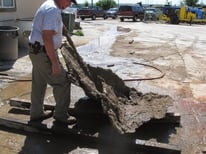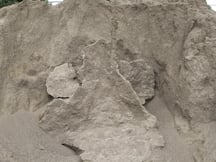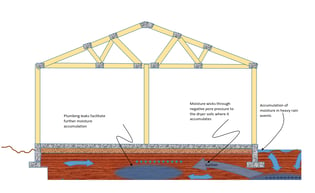 In one of my previous blogs, Grouting Smoke and Mirrors I discussed several types of grout with advantages and disadvantages for each type in particular applications. I would like to focus in particular about Chemical Grouting or Foam Grouting in this article, outlining the uses, advantages and limitations of this particular form of grouting.
In one of my previous blogs, Grouting Smoke and Mirrors I discussed several types of grout with advantages and disadvantages for each type in particular applications. I would like to focus in particular about Chemical Grouting or Foam Grouting in this article, outlining the uses, advantages and limitations of this particular form of grouting.
Foam Grouting is usually done with a polyurethane material that can be either in a 1 part or 2 part mix. The urethane can be hydrophobic or hydrophilic. Hydrophobic urethanes are averse to mixing with water and usually are more dimensionally more stable in the absence of water. Hydrophilic urethanes seek out water and react with it, and with the absence of water can shrink.
Foam grouts are best used in waterproofing applications as curtain walls in soils or for crack injection for concrete structures. The other common use is in mud jacking. The advantages are that it can be injected fast with smaller equipment, making it ideal for minimal down time areas and locations where floor finishes are critical to maintain.
 Some contractors and suppliers, one in particular claim that foam grouting is suitable for deep soil improvement and have even convinced some state road agencies that it is useful in that application. I respectfully disagree.
Some contractors and suppliers, one in particular claim that foam grouting is suitable for deep soil improvement and have even convinced some state road agencies that it is useful in that application. I respectfully disagree.
The Geo Institute in conjunction with the ASCE has conducted numerous tests of grout mixes by injecting them into the soil and then testing the soil and digging them up to observe the geometry of the grout. When the gradation of the mix is such that the internal shear properties of the grout are too low, then the inflation of the grout in the soil does not form round bulbous type formations, but rather thin fins indicating no compaction of the soil, but rather fracturing of the soil resulting in a loss of soil bearing capacity. This usually occurs when there are viscosity modifiers such as Bentonite or lime added to the mix, or even too much water. The picture at the top of the post is an example of what the grout geometry should look like.
By definition then, urethanes in the liquid state before activation, lack the required internal shear needed to form round bulbous formations to compact the soil and will result in soil fracturing with an accompanying loss in soil bearing capacity. How about in practice? Does it really do this? It has been requested numerous times for anyone to provide evidence to prove the geometry of deep urethane foam that would compact soils as opposed to fracturing them.
 It so happens that I do have pictures showing evidence of thin fin formations of urethane foams attached here for your viewing. These pictures demonstrate conclusively that the foam is fracturing the soil as opposed to compacting it.
It so happens that I do have pictures showing evidence of thin fin formations of urethane foams attached here for your viewing. These pictures demonstrate conclusively that the foam is fracturing the soil as opposed to compacting it.
Despite the clear and compelling evidence, people and agencies (ADOT in particular) still cling onto the smoke and mirrors hype that has been sold to them by very good sales teams using anecdotal evidence of prior claims of success. The anecdotal evidence of course in individual cases is contradicted by equally convincing evidence of failure in both the private and public works arenas.






